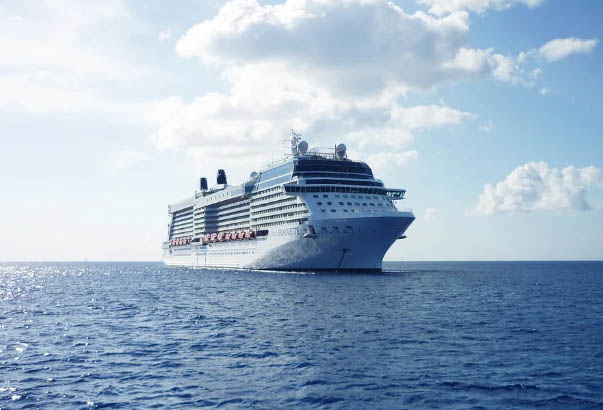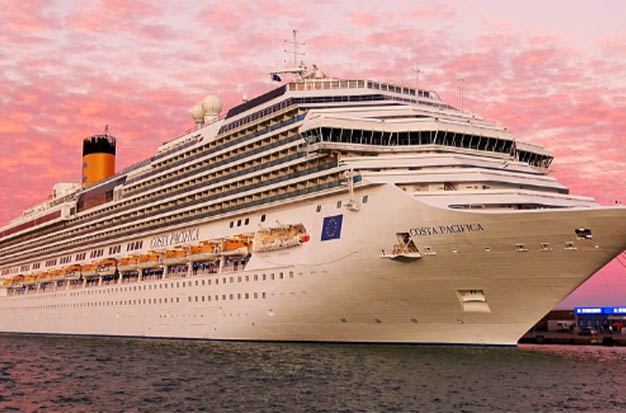Knowing that these enormous waves caused by Tsumani may make you feel uneasy about cruising. I’ll do my best to ease your concerns. Let’s examine what rogue wave is, how frequent they are, and how cruise ships can withstand them.
Can A Tsunami Affect & Swamp A Cruise Ship?
Particularly with regard to tsunamis, undersea earthquakes are typically the culprit. Then, rather than floating above the water, they move deeply through it. It follows that a cruise ship traveling in open water might hardly notice a tsunami rolling far beneath it. More dangerous than regular waves are rogue ones. They can grow up to 25 meters tall, are much steeper than a typical wave, and appear seemingly out of nowhere. That is a wall of water literally coming your way.
But don’t lose hope; you won’t actually flip. Cruising vessels today are enormous. Approximately 300 meters long and weighing more than 100,000 tonnes, a typical cruise ship is really, really big. Up to 360 meters and 225,000 tonnes are the maximum dimensions of the largest ships on the water. In essence, a ship will be more stable against extremely large waves the larger it is. High-tech stabilizers installed on contemporary cruise ships enable them to counteract ocean motion. They are the reason you hardly ever even notice the ship moving while you’re on it. The stabilizers will ensure the ship stays upright when confronted with a rogue wave. The Poseidon sank because the crew was not properly trained to steer into waves rather than avoid them altogether.
What Is A Rogue Wave?
A rogue wave is one that appears suddenly on the surface and is unusually large for that area of the ocean. It is thought that a combination of strong currents and high winds is what causes smaller waves to merge, though research into their cause is still ongoing.
Tsunamis are known to be caused by earthquakes, which presents another potential risk to seagoing passengers. However, a cruise ship’s location has a significant impact on whether it is in any danger.
Experts concur that the waves from a tsunami are unlikely to have any effects on a cruise ship as it travels out over a body of water.
The length of a tsunami’s wavelength at sea will probably be in the tens of kilometers, according to Dr. Scott Miller, a research associate at the Atmospheric Sciences Research Center of the State University of New York at Albany
What Extent Do Rogue Waves Have?
The official tallest rogue wave isn’t the tallest wave ever because the definition of a rogue wave is relative to the sea state. Instead, scientists have determined that the wave that is largest in relation to other nearby waves is the one that qualifies as the “biggest rogue wave.”
Off the Canadian coast of British Columbia, a wave measuring 58 feet tall was officially the tallest rogue wave ever seen. It was discovered in 2020. It was nearly three times higher than the waves around it at that height.

Rogue Waves Vs Tsunamis Vs Tidal Waves
Rogue waves occasionally resemble tidal waves or tsunamis, but only in name. Each of the three stands out clearly.
Let’s start with the term “tidal wave,” which is simply the name given by scientists to the waves produced by the tide and brought on by the moon’s gravitational pull. We can therefore determine when the moon is in each of its phases, making them entirely predictable.
In the past, tsunamis have occasionally been mistaken for tidal waves, but that is incorrect. A tsunami is a recognizable, isolated wave that results from a significant shift in the water. Typically, this movement of the plates is brought on by an earthquake that occurs below the surface.
Afterward, a sizable movement of the enormous displaced water swell will occur. Since it only affects the water level and doesn’t result in the formation of any single, large wave, it won’t be very noticeable at sea. Tsunamis therefore rarely pose a threat to ships at sea.
The issue is that the massive swell will continue to coastal areas, where it will merge into one enormous wall of water and crash against the shore.
While the full causes of rogue waves are still unknown, we do know they are unrelated to land movements or the normal gravitational pull. Rogue waves are unpredictable, one-time events. They pose a greater threat to ships at sea when they come as a single wave.
Can A Rogue Wave Capsize A Ship?
While most contemporary ships are constructed to withstand them, a tall enough rogue wave could sink one. Although they are more vulnerable, smaller ships are also more maneuverable and have a better chance of navigating around the wave.
Only one ship has been hit by a rogue wave and sunk since rogue waves began to be formally documented in 1995. That was the R/V Ballena, a 56-foot research vessel that overturned in 2000 before shattering against the rocky shore.
A Cruise Ship Can It Flip Due To A Wave?
It is extremely unlikely that a wave could flip a cruise ship. They are made to be wide and have enough ballast on the lower decks to be heavy enough to withstand rogue waves. Additionally, for the ship to hit perfectly on the side, the crew’s negligence would be necessary.
The only way a cruise ship could capsize is if a wave struck it perpendicularly on the port or starboard side, along the beam. Ships usually aim to strike a wave bow first.
Rogue waves have the peculiarity that, despite being sudden and unpredictable, you can hardly miss them. The navigation crew’s responsibility is to watch for and respond to hazards like rogue waves so they won’t be caught off guard by a massive wave that suddenly approaches the ship.
Conclusion
The idea of being trapped on a cruise ship as an earthquake or tsunami trembles the vast body of water surrounding them is undoubtedly terrifying for passengers at sea.
What is the likelihood that these climatic events will endanger ship passengers seriously? Although a ship might be able to sense an earthquake’s effects, it’s extremely rare that damage would occur.

